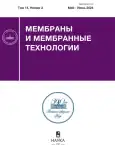Сравнение гомогенной анионообменной мембраны на основе сополимера N,N-диаллил-N,N-диметиламмоний хлорида и коммерческих анионообменных мембран при электродиализной переработке разбавленного раствора хлорида натрия
- Авторы: Бондарев Д.А.1, Самойленко А.А.1, Мельников С.С.1
-
Учреждения:
- Кубанский государственный университет
- Выпуск: Том 14, № 3 (2024)
- Страницы: 200-210
- Раздел: Статьи
- Статья опубликована: 24.10.2024
- URL: https://modernonco.orscience.ru/2218-1172/article/view/674228
- DOI: https://doi.org/10.31857/S2218117224030031
- EDN: https://elibrary.ru/MSFRIP
- ID: 674228
Цитировать
Полный текст
Аннотация
В настоящей работе исследован процесс электродиализной переработки разбавленного раствора хлорида натрия с использованием коммерческих анионообменных мембран – гетерогенной МА-41 и гомогенной Neosepta АМХ и экспериментальной гомогенной мембраны МА-1. Скорость обессоливания и значение предельного тока для исследованных анионообменных мембран возрастает в ряду МА-41, МА-1, AMX. Установлено, что для коммерческих мембран процесс обессоливания при поддержании постоянного скачка потенциала на мембране сопровождается переходом в сверхпредельное состояние, и развитием сопряженных эффектов концентрационной поляризации – для мембраны AMX повышается полезный массоперенос за счет электроконвекции, а для мембраны МА-41 поток ионов соли снижается из-за протекания реакции диссоциации воды. Для мембраны МА-1 снижение концентрации раствора, наоборот, приводит к переходу системы в допредельное состояние, что может быть связано со значительным вкладом равновесной электроконвекции в процесс переноса ионов в разбавленных растворах в электромембранных системах с данной мембраной. Такое различие в свойствах мембран МА-1 и AMX приводит к тому, что коэффициенты массопереноса для мембраны МА-1 выше, по сравнению с мембраной AMX при скачках потенциала 1 и 2 В. Наиболее оптимальным режимом работы для мембраны МА-1 является скачок потенциала в электромембранной системе 1 В, при котором удельные энергозатраты составляют 0,24 кВт-ч/моль. В сравнимых условиях для мембраны AMX удельные энергозатраты составляют 0,34 кВт-ч/моль.
Полный текст
Об авторах
Д. А. Бондарев
Кубанский государственный университет
Автор, ответственный за переписку.
Email: bondarev.denis1992@outlook.com
Россия, 350040, ул. Ставропольская, 149, г. Краснодар
А. А. Самойленко
Кубанский государственный университет
Email: bondarev.denis1992@outlook.com
Россия, 350040, ул. Ставропольская, 149, г. Краснодар
С. С. Мельников
Кубанский государственный университет
Email: melnikov.stanislav@gmail.com
Россия, 350040, ул. Ставропольская, 149, г. Краснодар
Список литературы
- Э.М. Балавадзе , О.В. Бобрешова, П.И. Кулинцов, Успехи химии, 57, 1031 (1988).
- H. Strathmann, Desalination, 264, 268 (2010). https://doi.org/10.1016/j.desal.2010.04.069
- P. Kumar, S.M. Rubinstein, I. Rubinstein, B. Zaltzman, Physical Review Research, 2, 033365 (2020). https://doi.org/10.1103/PhysRevResearch.2.033365
- L. Zhang, H. Jia, J. Wang, H. Wen, J. Li, J. Membr. Sci., 594, 117443, (2020) https://doi.org/10.1016/j.memsci.2019.117443
- V.V. Nikonenko, S.A. Mareev, N.D. Pis ’ menskaya, A.M. Uzdenova, A.V. Kovalenko, M.K. Urtenov, G. Pourcelly, Russ. J. Electrochem. 53, 1122 (2017). https://doi.org/10.1134/S1023193517090099
- V.A. Shaposhnik, V.I. Vasil’eva, D.B. Praslov, J. Membr. Sci., 101, 23 (1995). https://doi.org/10.1016/0376-7388(94)00270-9
- Y. Sano, X. Bai, S. Amagai, A. Nakayama, Desalination, 444, 151 (2018). https://doi.org/10.1016/j.desal.2018.01.034
- E.M. Akberova, V.I. Vasil’eva, V.I. Zabolotsky, L. Novak, J. Memb. Sci. 566, 317, (2018). https://doi.org/10.1016/j.memsci.2018.08.042
- N.A. Mishchuk, Colloids Surf. A Physicochem. Eng. Asp., 140, 75 (1998). https://doi.org/10.1016/S0927-7757(98)00216-7
- I. Rubinshtein, B. Zaltzman, J. Pretz, C. Linder, Russ. J. Electrochem., 38, 853 (2002). https://doi.org/10.1023/A:1016861711744
- V.I. Zabolotsky, A.V. Kovalenko, V.V. Nikonenko, M.H. Urtenov, K.A. Lebedev et al., Petroleum Chemistry, 57, 779 (2017). https://doi.org/10.1134/S0965544117090109
- V.I. Zabolotskiy, A.Y. But, V.I. Vasil ’ eva, E.M. Akberova, S.S. Melnikov, J. Membr. Sci. 526, 60 (2017). https://doi.org/10.1016/j.memsci.2016.12.028
- K.A. Nebavskaya, V.V. Sarapulova, K.G. Sabbatovskiy, V.D. Sobolev, et al., J. Membr. Sci., 523, 36 (2017). https://doi.org/10.1016/j.memsci.2016.09.038
- K.A. Nebavskaya, D.Y. Butylskii, I.A. Moroz, A.V. Nebavsky, N.D. Pismenskaya, V.V. Nikonenko, Petroleum Chemistry, 58, 780 (2018). https://doi.org/10.1134/S0965544118090086
- N.D. Pismenskaya, E.V. Pokhidnia, G. Pourcelly, V.V. Nikonenko, J. Membr. Sci., 566, 54 (2018). https://doi.org/10.1016/j.memsci.2018.08.055
- Bondarev D., Melnikov S., Zabolotskiy V. J. Membr. Sci., 675, 121510 (2023). https://doi.org/10.1016/j.memsci.2023.121510
- Y. Tanaka, M. Iwahashi, M. Kogure, J. Membr. Sci., 92, 217 (1994) https://doi.org/10.1016/0376-7388(94)00058-1.
- V.V. Nikonenko, A.G. Istoshin, M.Kh. Urtenov, V.I. Zabolotsky, C. Larchet, J. Benzaria, Desalination, 126, 207 (1999) https://doi.org/10.1016/S0011-9164(99)00176-9
- N.D. Pismenskaya, V.V. Nikonenko, N.A. Melnik, K.A. Shevtsova, E.I. Belova, G. Pourcelly, D. Cot, L. Dammak, C. Larchet, J. Phys. Chem. B. 116, 2145 (2012) https://doi.org/10.1021/jp2101896
- J.H. Choi, H.J. Lee, S.H. Moon, J. Colloid Interface Sci., 238, 188 (2001). https://doi.org/10.1006/jcis.2001.7510
- V.V. Nikonenko, N.D. Pismenskaya, E.I. Belova et al., Adv. Colloid Interface Sci., 160, 101 (2010). https://doi.org/10.1016/j.cis.2010.08.001
Дополнительные файлы















